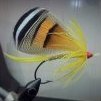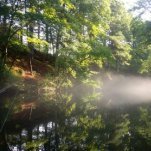-
Content Count
1,278 -
Joined
-
Last visited
Community Reputation
0 NeutralAbout flykid
-
Rank
Advanced Member
- Birthday 09/25/1992
Previous Fields
-
Favorite Species
Brook Trout
-
Security
22
Recent Profile Visitors
3,184 profile views
-
Very cool! Great hook and a nice style, love the look of the longer, curled fibers!
-
Hi DarrelP, Not to step on OP's toes, but that wing is what's referred to as a "mixed wing". Without referencing the pattern it looks like it is made up of Golden Pheasant tail (or maybe Florican Bustard), Lady Amherst Pheasant tail, Kori Bustard, Golden pheasant tippet, and Guinea Fowl. May have missed a feather or two. Small strips are stacked on top of each other (the broad way, not edge to edge) then tied in and stroked back with the fingers. This breaks up the fibers a little bit and causes them to mix. Anyone who knows the makeup of the wing better please feel free to correct me.
-
I love this pattern! Never tied it, but maybe I need to put it on the list. Very nice!
-
Thanks for sharing! The body work in particular looks nicely done.
-
Well done! I've never tied this one. Looks like your method for tying the veilings in first then completing the body worked nicely. The hook looks good too! Thanks for sharing!
-
Trains sure are a cool way to go. I haven't gone too far on one, just to Chicago from Michigan City, IN. But I always enjoyed that trip and am slightly fascinated by rail transportation.
-
Looking forward to seeing it! The Popham is very tricky and I think I've only tied it once. But, it is one of my favorite patterns so I will stay tuned!
-
It is most definitely a labor of love! Even when I was learning to tie my own flies the mentors told me it was surely not a money saving effort. Boy, were they right!
-
Thanks for sharing, George! I haven't tied this one before either. I do like the low wing profile. We definitely don't win them all, but I'm sure you still at least got something out of the process even if not fully satisfied.
-
Salarman definitely explained it well and I assure you I personally take no offense to the question! I've been looking and learning and tying these flies for 15-16 year now so I think those of us who have seen so many patterns and variations of patterns and takes on patterns probably notice some of these nuances more than people who are new to the style or less involved or interested in it. Many do have the same style and many have similar color schemes. One tier's wing may also be constructed differently than another's but it may still be the same pattern using the same feathers which adds a whole other level of difficulty in determining what constitutes a new or different pattern. But, to answer the question of what makes this one unusual in my eyes: First, all the components of the wing are dyed. Often times (absolutely not always) the wing is a mix of dyed feathers and natural feathers which lend more of the browns and tans seen in many flies. Then the colors themselves are not commonly seen together, the bright green, red, white and claret would stick out on a page of classic fly patterns as pretty recognizable. You see a lot of blue, white, yellow, red, black in various combinations. It's definitely a whole other world of fly tying that has claimed a great deal of my time and money!
-
Nicely done! I've never tied this one either. I do enjoy the unusual color scheme in the wing. Thanks for sharing!
-
Check feathersmc.com John sometimes has different feathers in stock that fit the bill. Just depends on what is in stock at the moment, but you can't go wrong with him.
-
Thanks for the feedback! Good tip about using the liquid wax, I do have some so I will have to give that a try. You definitely should give them a shot. It's really kind of refreshing to look through some of the less commonly seen patterns. I'll keep an eye out for your pictures should you choose to share!
-
This one is a little messy. Tricky to get things to lay the right way on these small hooks. I do love the bold, bright colors though. I think the body is pig's wool which is tricky to dub at any size. You also see the golden pheasant crest underwing which you don't see on a lot of salmon flies, but seem to be relatively common in the Blacker patterns.
-
Number 3 from the series. Apologies for the garbage picture. This one is a little different. Very earthy and natural colors and materials and a cool partridge collar instead of a normal throat hackle.




.thumb.JPG.34e862dceb3dd8be4646d978796518d1.JPG)

